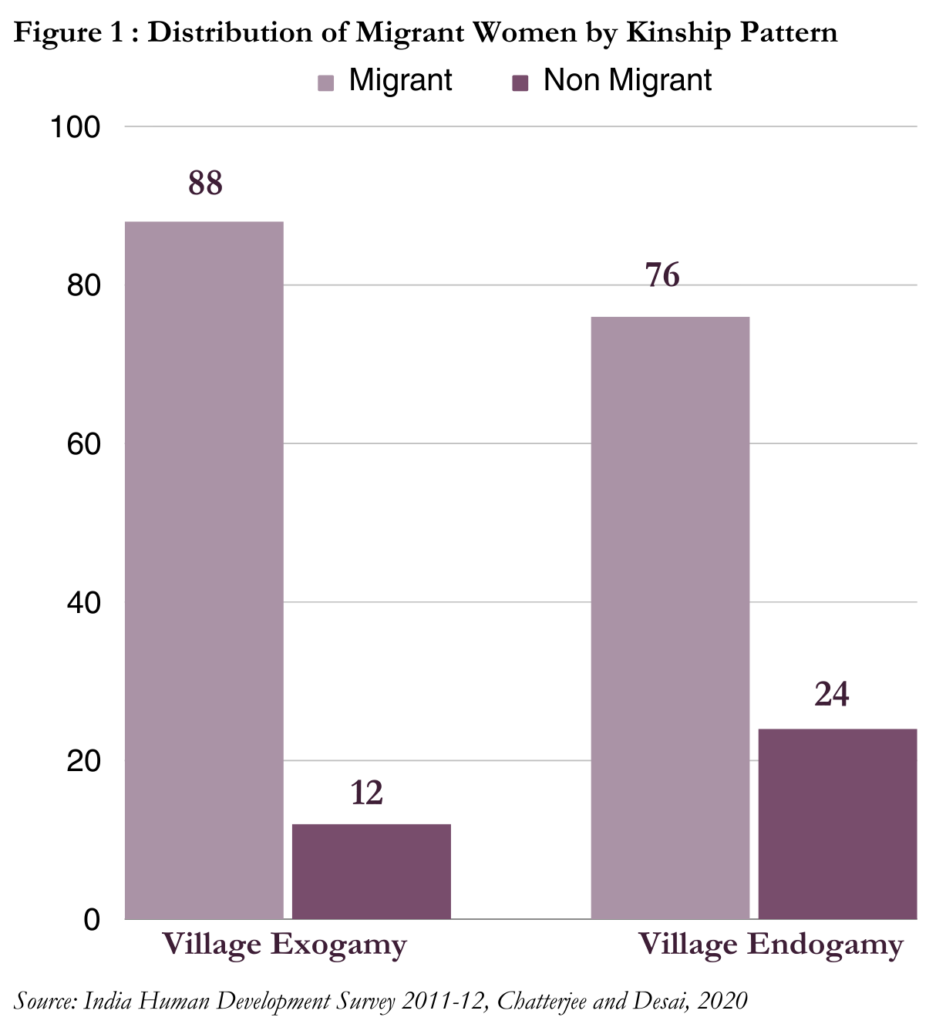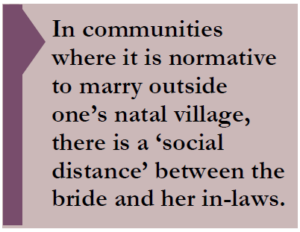
 Internal migration is a key indicator of changing population dynamics within a country. It is driven by several factors such as employment opportunities, education, climate-related factors, and marriage. Literature on migration usually centers around who migrates and who doesn’t, and on how migrants assimilate in the destination. Focus on gender in these broad areas is limited. Most of the literature on the determinants of migration focuses on men’s experiences, particularly in the context of distress-related and labor migration. Gender is incorporated into this by examining feminization of labor migration or by looking at the role male migration plays in impacting the lives of left- behind wives (Desai and Banerji 2008; Gulati 1993; Menjivar and Agadjanian 2007; Lei and Desai 2021).
Internal migration is a key indicator of changing population dynamics within a country. It is driven by several factors such as employment opportunities, education, climate-related factors, and marriage. Literature on migration usually centers around who migrates and who doesn’t, and on how migrants assimilate in the destination. Focus on gender in these broad areas is limited. Most of the literature on the determinants of migration focuses on men’s experiences, particularly in the context of distress-related and labor migration. Gender is incorporated into this by examining feminization of labor migration or by looking at the role male migration plays in impacting the lives of left- behind wives (Desai and Banerji 2008; Gulati 1993; Menjivar and Agadjanian 2007; Lei and Desai 2021).
There were about 400 million internal migrants in India and about two-thirds of them migrated because of marriage (UNESCO 2013). Even though migration for marriage is one of the main reasons behind migration, particularly for women (about 87% female migrants primarily migrate because of marriage) (Government of India, 2022), there is not enough focus on the understanding of this type of migration. Using data from the India Human Development Survey (IHDS) 2011-12 for more than 34,000 ever married-women aged 15-49, our paper examines how women’s autonomy in different spheres is shaped differently by: a) actual migration (women physically migrating for marriage); and b) by norms in a woman’s community around marriage migration (Chatterjee and Desai 2020).
 Our paper highlights two distinct facets of marriage migration: one indicating a change in the community of residence post- marriage (whether a woman grew up in the same place where she stays post marriage); and the other indicating norms in a woman’s community (whether in a woman’s community or caste group it is permissible to marry a daughter within her village).
Our paper highlights two distinct facets of marriage migration: one indicating a change in the community of residence post- marriage (whether a woman grew up in the same place where she stays post marriage); and the other indicating norms in a woman’s community (whether in a woman’s community or caste group it is permissible to marry a daughter within her village).
We further examine how these two aspects can differentially impact women’s (a) physical autonomy (whether they can go alone to visit friends, relatives, health centers, grocery, etc.), (b) economic autonomy (full-time employment in wage work), and (c) autonomy with regard to civic participation (involvement in self-help groups).
There is a weak relationship between actual migration and kinship patterns and an even weaker relationship between geography and kinship patterns. For example, in communities where it is permitted to marry within one’s own village (village endogamy), few women end up marrying in their own village. This could be because there is possibly a greater preference towards marrying a ‘more qualified’ groom.
Again, for women who belong to communities that traditionally do not permit marrying grooms belonging to the same village (village exogamy), living in an urban area (a city like Delhi for instance) doesn’t mean not marrying within Delhi, but rather means not marrying someone belonging to the same native village (Grover 2017). Figure 1 shows that 12% of the women in our sample who belonged to communities that do not permit marrying someone from the same natal village stay on in the place where they grew up post-marriage, whereas about 24% of women who belong to communities which permit village endogamy live in the same village after marriage too.
Findings from our study show that non-migrants (those who grew up in the same place where they continued living after marriage) are more likely to be employed in full-time wage work compared to marriage migrants, that is those who migrated physically to a different place from where they grew up. This could partly be because women’s economic autonomy, indicated by a greater likelihood of participating in wage work, could add to the family income and thus is subject to lesser curtailment compared to other forms of autonomy.
Additionally, non-migrant women’s local social networks would help them find jobs in the area.
 In comparison, norms in a woman’s community about marriage migration are associated with all three aspects of women’s autonomy. Women who belong to communities that permit marriage within their natal village are likely to have higher physical autonomy, economic autonomy, and greater civic participation.
In comparison, norms in a woman’s community about marriage migration are associated with all three aspects of women’s autonomy. Women who belong to communities that permit marriage within their natal village are likely to have higher physical autonomy, economic autonomy, and greater civic participation.
This is because in communities where it is normative to marry outside one’s natal village, there is a ‘social distance’ between the bride and her in-laws; whereas in communities where marriages within the same village are permissible, brides have greater connection with their natal family and there are lesser restrictions on their mobility. These developments do not occur in one generation but unfold over a large time period and are ingrained as a part of gender norms in a community, impacting both non-migrant and migrant brides.
In conclusion, norms about marriage migration in the community to which a woman’s family belongs have a greater role in determining some dimensions of her autonomy in the public sphere compared to her physical migration to a new geographic area. Geography and culture are connected and evolve over time; culture and social norms shape and are in turn shaped by marriage migration.
References:
Chatterjee Esha & Desai Sonalde. 2020. “Physical versus imagined communities: migration and women’s autonomy in India.” Journal of Ethnic and Migration Studies 46(14): 2977-2996, DOI: 10.1080/1369183X.2019.1585016
Desai Sonalde, and Banerji Manjistha. 2008. “Negotiated Identities: Impact of Male Migration on Women.” Journal of Population Research 25 (3):337–355.
Gulati Leela. 1993. In the Absence of their Men: The Impact of Male Migration on Women. New Delhi: Sage Publications.
Government of India. 2022. Migration in India 2020-2021, Periodic Labour Force Survey (PLFS), July 2020 – June 2021. National Statistical Office, Ministry of Statistics and Programme Implementation, July.
Grover Shalini. 2017. Marriage, Love, Caste and Kinship Support. New Delhi: Routledge
Menjivar Cecilia, and Agadjanian Victor. 2007. “Men’s Migration and Women’s Lives: Views from Rural Armenia and Guatemala.” Social Science Quarterly 88 (5):1243–1262
United Nations Educational, Scientific and Cultural Organization (UNESCO). 2013. “Social Inclusion of Internal Migrants in India.” Paris: UNESCO.
_____________________________
Esha Chatterjee is an Assistant Professor at the Indian Institute of Technology Kanpur. She holds a PhD in Sociology (University of Maryland College Park, 2020). Her work has been published in journals such as Population and Development Review, Journal of Ethnic and Migration Studies, Population Studies, and Demographic Research.